Combined Effects of Densified Polystyrene and Unprocessed Fly Ash on Concrete Engineering Properties
Abstract
:1. Introduction
2. Materials and Methods
2.1. Materials
Production Process of SPS Aggregate
2.2. Concrete Mixtures
2.3. Testing Procedure
2.3.1. Compressive Strength
2.3.2. Ultrasonic Pulse Velocity (UPV)
- V is the pulse velocity, in km/s;
- L is the path length (100 mm), in mm; and
- T is the time taken by the pulse to transverse the 100 mm length, in μs.
2.3.3. Water Absorption
- Ws is the constant saturated weight of specimens; and
- Wd is the constant dry weight of specimens.
3. Results and Discussion
3.1. Consistency
3.1.1. Effect of SPS
3.1.2. Effect of FA
3.2. Density
3.2.1. Effect of SPS
3.2.2. Effect of FA
3.3. Compressive Strength
3.3.1. Effect of SPS
3.3.2. Effect of FA
3.3.3. Effect of Curing Time
3.3.4. Failure Mode
3.4. Ultrasonic Pulse Velocity
3.4.1. Effect of SPS
3.4.2. Effect of FA
3.5. Water Absorption
3.5.1. Effect of SPS
3.5.2. Effect of FA
4. Correlations
4.1. Strength, Density, and Volume
4.2. Strength and UPV
4.3. Strength and WA
5. Conclusions and Future Work
- LWAC containing 60% SPS aggregates and up to 40% FA can conform to the Type II structural and insulating strength requirement reported by RILEM (Table 4).
- The concrete containing high contents of SPS and FA can be used in low-strength concretes’ applications for example footpaths, cycle paths, and noise reduction barriers, or may be used to produce lightweight bricks and blocks with low thermal conductivity.
Acknowledgments
Author Contributions
Conflicts of Interest
References
- Mehta, P.K. Reducing the environmental impact of concrete. Concr. Int. 2001, 23, 61–66. [Google Scholar]
- Mehta, P.K. The next revolution in materials of construction. In Proceedings of the VII AIMAT Congress, Ancona, Italy, 29 June–2 July 2004. [Google Scholar]
- Sabaa, B.; Ravindrarajah, R.S. Engineering properties of lightweight concrete containing crushed expanded polystyrene waste. In Proceedings of the Materials Research Society, 1997 Fall Meeting Symposium MM: Advances in Materials for Cementitious Composites, Boston, MA, USA, 1–3 December 1997. [Google Scholar]
- Babu, K.G.; Babu, D.S. Behaviour of lightweight expanded polystyrene concrete containing silica fume. Cem. Concr. Res. 2003, 33, 755–762. [Google Scholar] [CrossRef]
- Ganesh Babu, D.; Ganesh Babu, K.; Wee, T.H. Properties of lightweight expanded polystyrene aggregate concretes containing fly ash. Cem. Concr. Res. 2005, 35, 1218–1223. [Google Scholar] [CrossRef]
- Miled, K.; Sab, K.; Le Roy, R. Particle size effect on EPS lightweight concrete compressive strength: Experimental investigation and modelling. Mechan. Mater. 2007, 39, 222–240. [Google Scholar] [CrossRef]
- Ismail, I.; Saim, A.A.; Saleh, A.L. Properties of hardened concrete bricks. In Proceedings of the 5th Asia-Pacific Structural Engineering and Construction Conference (APSEC 2003), Johor Bahru, Malaysia, 26–28 August 2003. [Google Scholar]
- Le Roy, R.; Parant, E.; Boulay, C. Taking into account the inclusions’ size in lightweight concrete compressive strength prediction. Cem. Concr. Res. 2005, 35, 770–775. [Google Scholar] [CrossRef]
- Chen, B.; Liu, J. Mechanical properties of polymer-modified concretes containing expanded polystyrene beads. Constr. Build. Mater. 2007, 21, 7–11. [Google Scholar] [CrossRef]
- Ganesh Babu, K.; Saradhi Babu, D. Performance of fly ash concretes containing lightweight EPS aggregates. Cem. Concr. Compos. 2004, 26, 605–611. [Google Scholar] [CrossRef]
- Babu, D.S.; Ganesh Babu, K.; Tiong-Huan, W. Effect of polystyrene aggregate size on strength and moisture migration characteristics of lightweight concrete. Cem. Concr. Compos. 2006, 28, 520–527. [Google Scholar] [CrossRef]
- Herki, B.A.; Khatib, J.M. Valorisation of waste expanded polystyrene in concrete using a novel recycling technique. Eur. J. Environ. Civ. Eng. 2016, 1–19. [Google Scholar] [CrossRef]
- British Standards Institution. Tests for Geometrical Properties of Aggregates—Part 1: Determination of Particle Size Distribution—Sieving Method; BS EN 933-1; British Standards Institution: London, UK, 1997. [Google Scholar]
- British Standards Institution. Testing Fresh Concrete—Part 2: Slump-Test; BS EN 12350-2; British Standards Institution: London, UK, 2009. [Google Scholar]
- British Standards Institution. Testing Hardened Concrete—Part 3: Compressive Strength of Test Specimens; BS EN 12390-3; British Standards Institution: London, UK, 2009. [Google Scholar]
- British Standards Institution. Testing Hardened Concrete—Part 4: Compressive Strength Testing Machine; BS EN 12390-4; British Standards Institution: London, UK, 2009. [Google Scholar]
- British Standards Institution. Testing Concrete—Part 4: Determination of Ultrasonic Pulse Velocity; BS EN 12504-4; British Standards Institution: London, UK, 2004. [Google Scholar]
- Kan, A.; Demirboğa, R. Effect of cement and EPS beads ratios on compressive strength and density of lightweight concrete. Indian J. Eng. Mater. Sci. 2007, 14, 158–162. [Google Scholar]
- Ferrándiz-Mas, V.; García-Alcocel, E. Durability of expanded polystyrene mortars. Constr. Build. Mater. 2013, 46, 175–182. [Google Scholar] [CrossRef] [Green Version]
- Hassanpour, M.; Shafigh, P.; Mahmud, H. Lightweight aggregate concrete fibre reinforcement—A review. Constr. Build. Mater. 2012, 37, 452–461. [Google Scholar] [CrossRef]
- Anwar Hossain, K.M. Properties of volcanic pumice based cement and lightweight concrete. Cem. Concr. Res. 2004, 34, 283–291. [Google Scholar] [CrossRef]
- Demirboga, R.; Kan, A. Thermal conductivity and shrinkage properties of modified waste polystyrene aggregate concretes. Constr. Build. Mater. 2012, 35, 730–734. [Google Scholar] [CrossRef]
- Kim, H.K.; Jeon, J.H.; Lee, H.K. Workability, and mechanical, acoustic and thermal properties of lightweight aggregate concrete with a high volume of entrained air. Constr. Build. Mater. 2012, 29, 193–200. [Google Scholar] [CrossRef]
- Khatib, J.M. Performance of self-compacting concrete containing fly ash. Constr. Build. Mater. 2008, 22, 1963–1971. [Google Scholar] [CrossRef]
- British Standards Institution. Testing Hardened Concrete—Part 7: Density of Hardened Concrete; BS EN 12390-7; British Standards Institution: London, UK, 2009. [Google Scholar]
- British Standards Institution. Concrete—Part 1: Specification, Performance, Production and Conformity; BS EN 206-1; British Standards Institution: London, UK, 2000. [Google Scholar]
- Demirboga, R.; Gül, R. The effects of expanded perlite aggregate, silica fume and fly ash on the thermal conductivity of lightweight concrete. Cem. Concr. Res. 2003, 33, 723–727. [Google Scholar] [CrossRef]
- Tang, W.C.; Lo, Y.; Nadeem, A. Mechanical and drying shrinkage properties of structural-graded polystyrene aggregate concrete. Cem. Concr. Compos. 2008, 30, 403–409. [Google Scholar] [CrossRef]
- Lo, T.Y.; Tang, W.C.; Cui, H.Z. The effects of aggregate properties on lightweight concrete. Build. Environ. 2007, 42, 3025–3029. [Google Scholar] [CrossRef]
- Cui, H.Z.; Lo, T.Y.; Memon, S.A.; Xu, W. Effect of lightweight aggregates on the mechanical properties and brittleness of lightweight aggregate concrete. Constr. Build. Mater. 2012, 35, 149–158. [Google Scholar] [CrossRef]
- Sadrmomtazi, A.; Sobhani, J.; Mirgozar, M.A.; Najimi, M. Properties of multi-strength grade EPS concrete containing silica fume and rice husk ash. Constr. Build. Mater. 2012, 35, 211–219. [Google Scholar] [CrossRef]
- Demirboğa, R.; Türkmen, İ.; Karakoç, M.B. Relationship between ultrasonic velocity and compressive strength for high-volume mineral-admixtured concrete. Cem. Concr. Res. 2004, 34, 2329–2336. [Google Scholar] [CrossRef]
- Snelson, D.G.; Kinuthia, J.M.; Davies, P.A.; Chang, S.-R. Sustainable construction: Composite use of tyres and ash in concrete. Waste Manag. 2009, 29, 360–367. [Google Scholar] [CrossRef] [PubMed]
- International Union of Laboratories and Experts in Construction Materials, Systems and Structures (RILEM). Functional Classification of Lightweight Concretes, 2nd ed.; RILEM: Paris, France, 1978. [Google Scholar]
- Ramezanianpour, A.A.; Malhotra, V.M. Effect of curing on the compressive strength, resistance to chloride-ion penetration and porosity of concretes incorporating slag, fly ash or silica fume. Cem. Concr. Compos. 1995, 17, 125–133. [Google Scholar] [CrossRef]
- Wang, H.Y. Durability of self-consolidating lightweight aggregate concrete using dredged silt. Constr. Build. Mater. 2009, 23, 2332–2337. [Google Scholar] [CrossRef]
- Siddique, R.; Khatib, J.; Kaur, I. Use of recycled plastic in concrete: A review. Waste Manag. 2008, 28, 1835–1852. [Google Scholar] [CrossRef] [PubMed]
- Gadea, J.; Rodríguez, A.; Campos, P.L.; Garabito, J.; Calderón, V. Lightweight mortar made with recycled polyurethane foam. Cem. Concr. Compos. 2010, 32, 672–677. [Google Scholar] [CrossRef]
- Yew, M.K.; Mahmud, H.B.; Ang, B.C.; Yew, M.C. Effects of heat treatment on oil palm shell coarse aggregates for high strength lightweight concrete. Mater. Des. 2014, 54, 702–707. [Google Scholar] [CrossRef]
- Albano, C.; Camacho, N.; Hernández, M.; Matheus, A.; Gutiérrez, A. Influence of content and particle size of waste pet bottles on concrete behaviour at different w/c ratios. Waste Manag. 2009, 29, 2707–2716. [Google Scholar] [CrossRef] [PubMed]
- Euro-International Committee for Concrete. Diagnosis and Assessment of Concrete Structures: State of the Art Report; CEB Inc.: Arlington, VA, USA, 1989. [Google Scholar]
- Unal, O.; Uygunoglu, T.; Yildiz, A. Investigation of properties of low-strength lightweight concrete for thermal insulation. Build. Environ. 2007, 42, 584–590. [Google Scholar] [CrossRef]
- Sengul, O.; Azizi, S.; Karaosmanoglu, F.; Tasdemir, M.A. Effect of expanded perlite on the mechanical properties and thermal conductivity of lightweight concrete. Energy Build. 2011, 43, 671–676. [Google Scholar] [CrossRef]

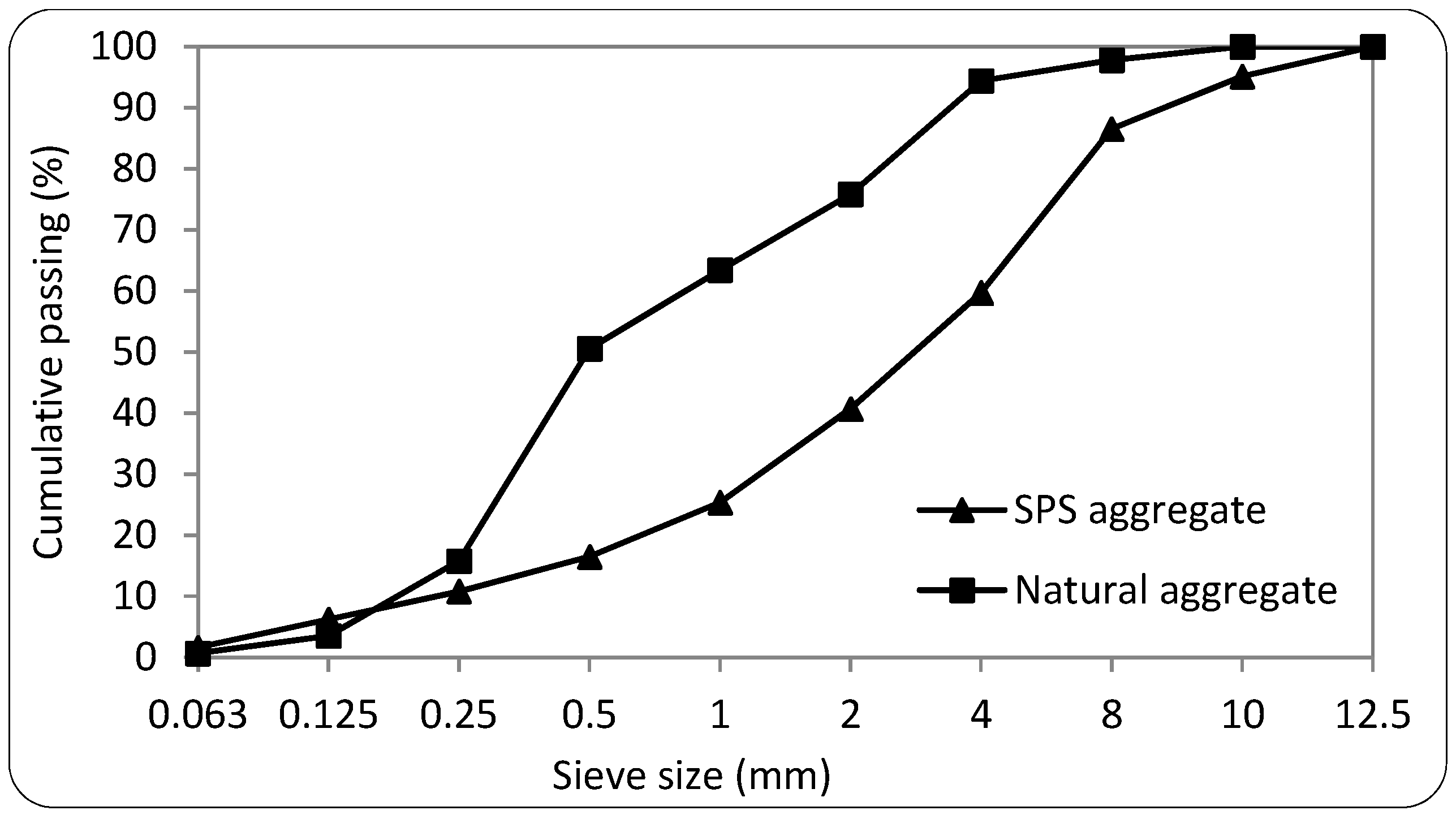
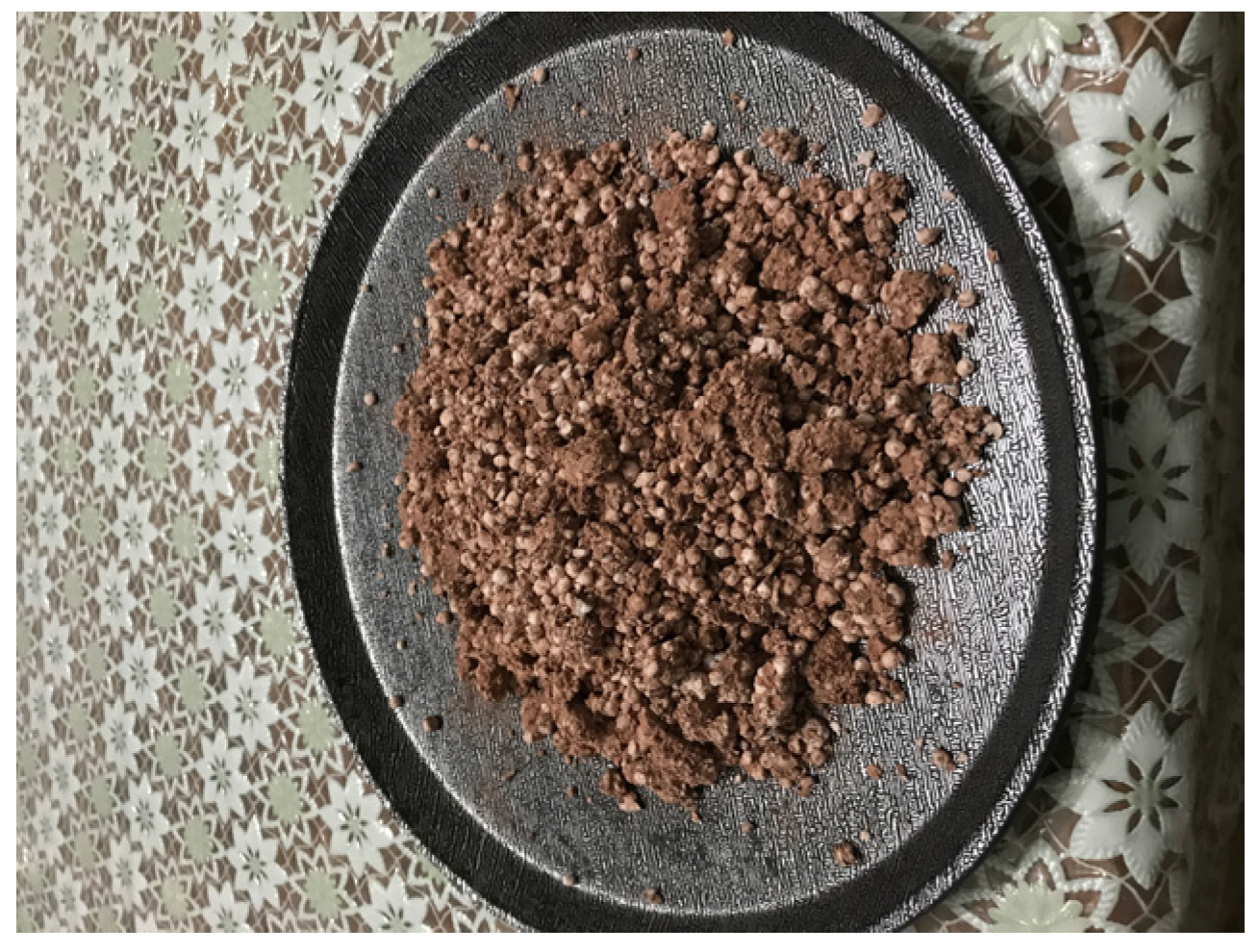
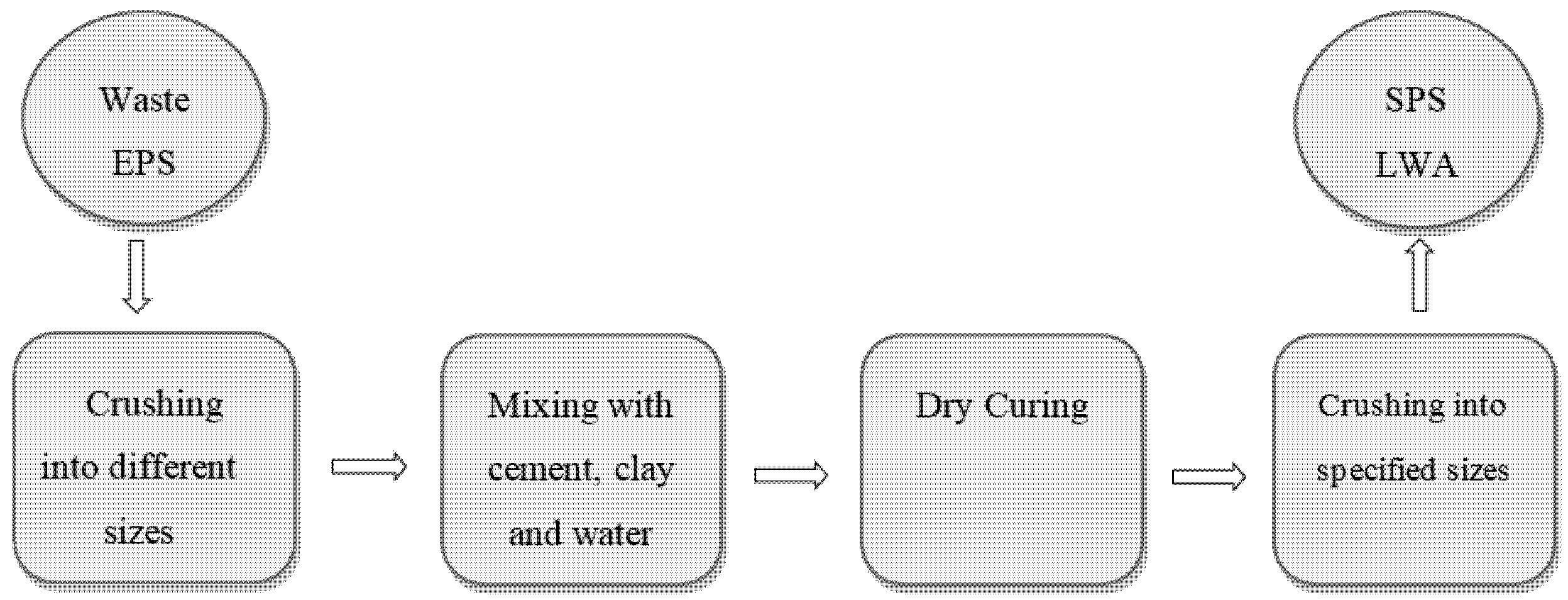
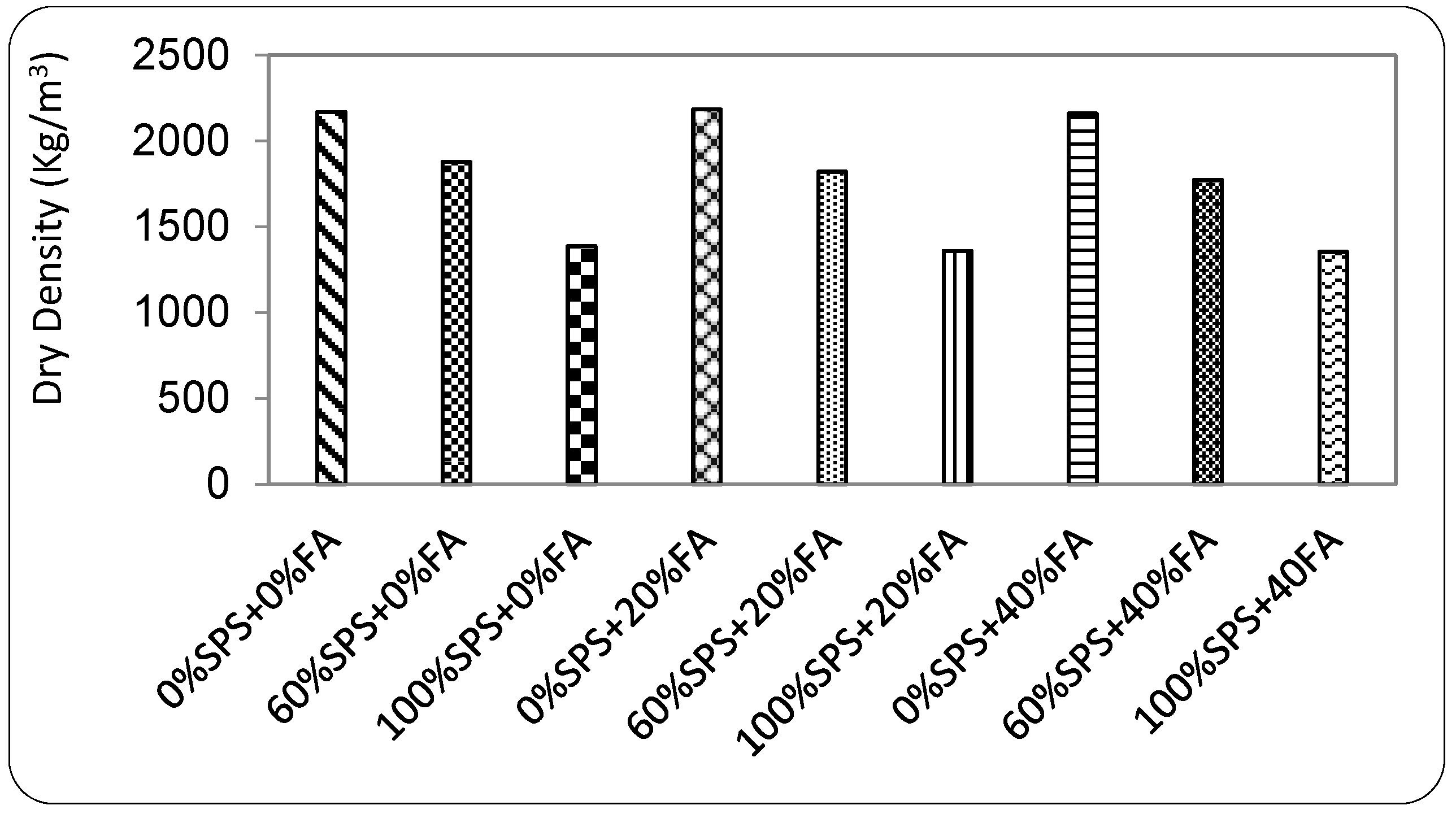
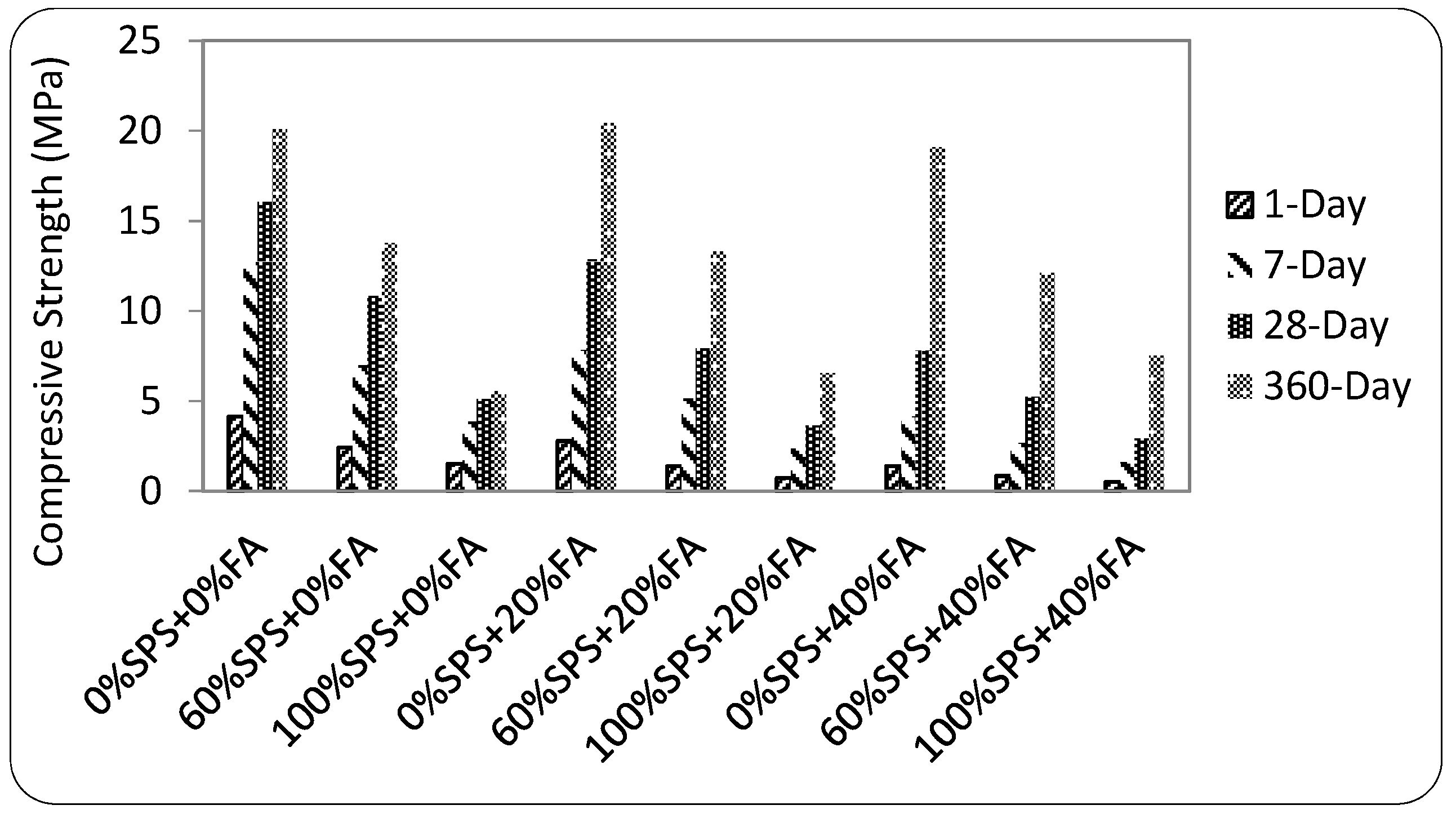

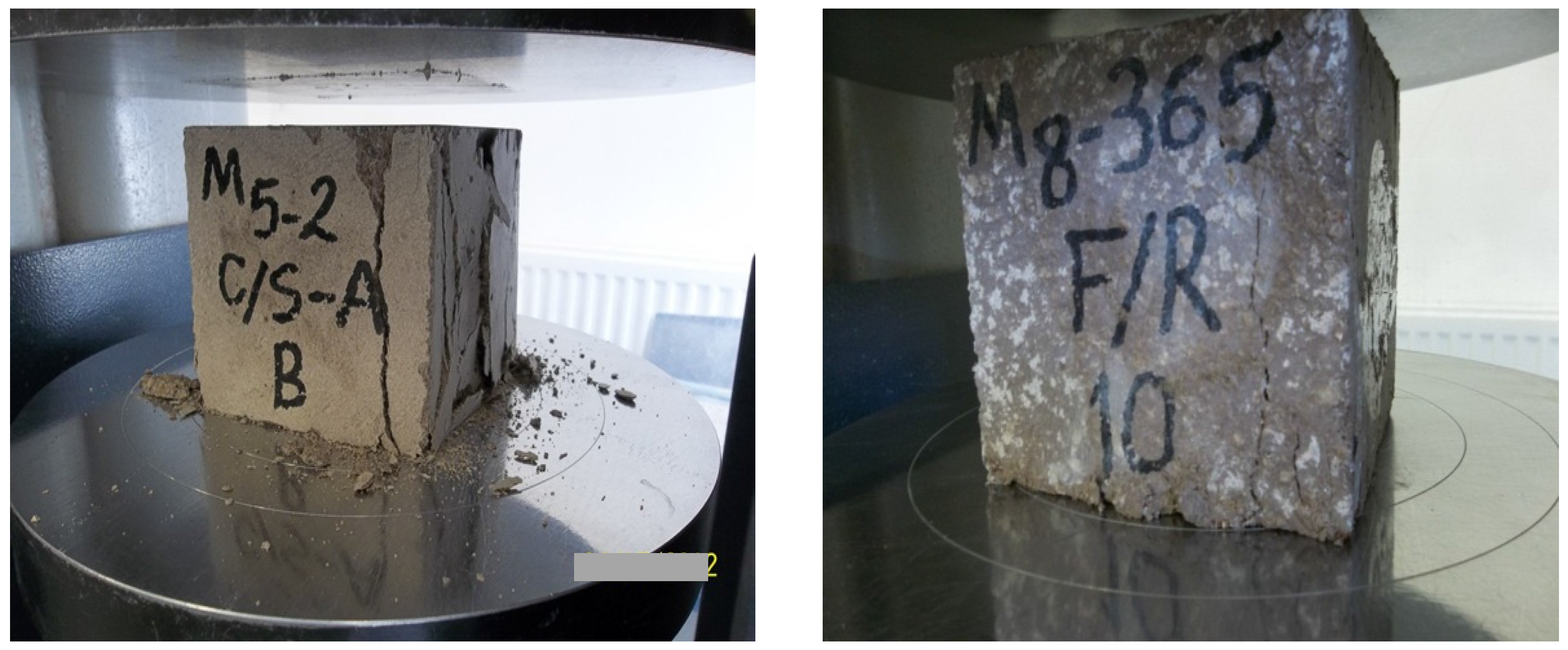

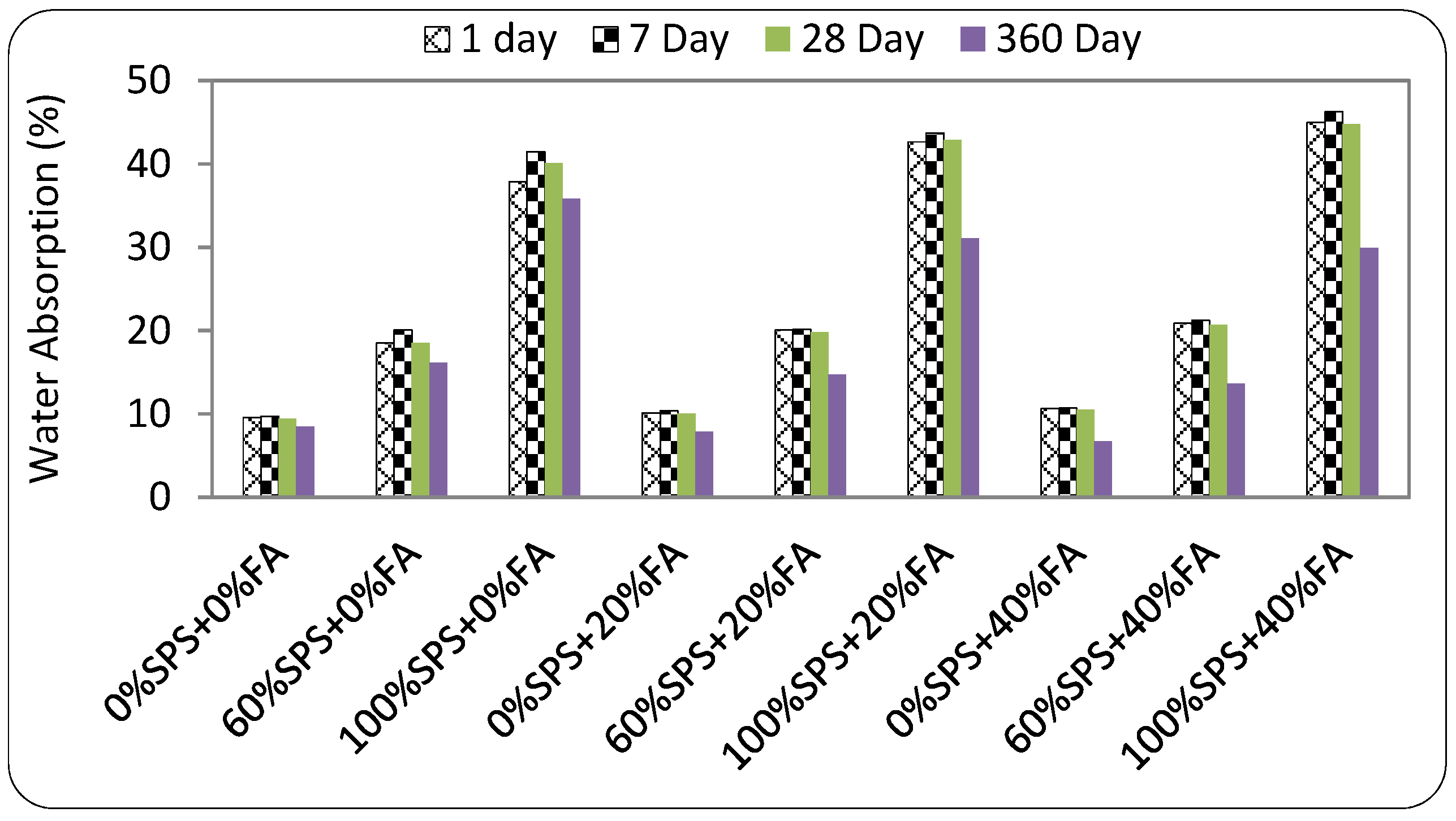
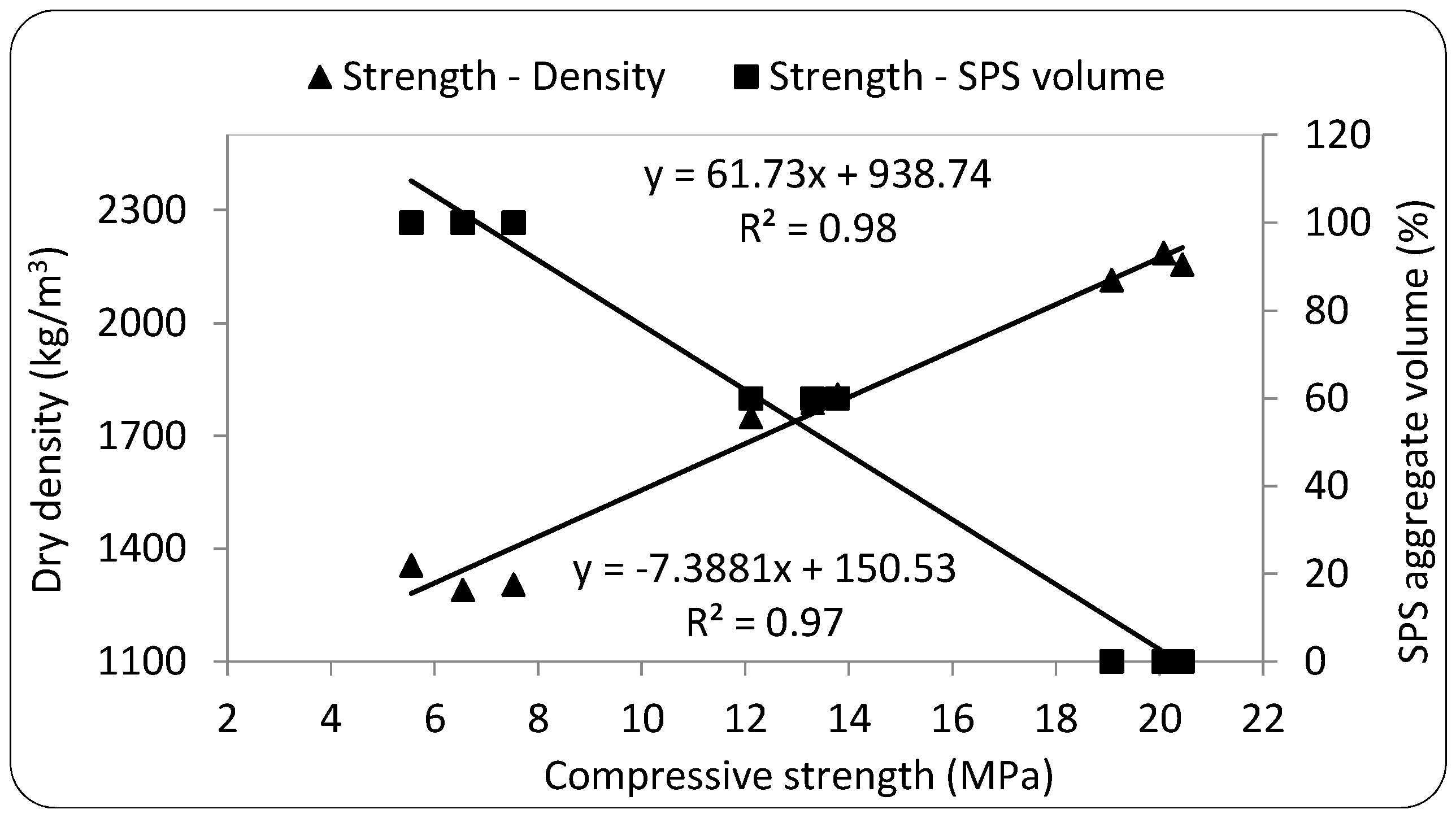
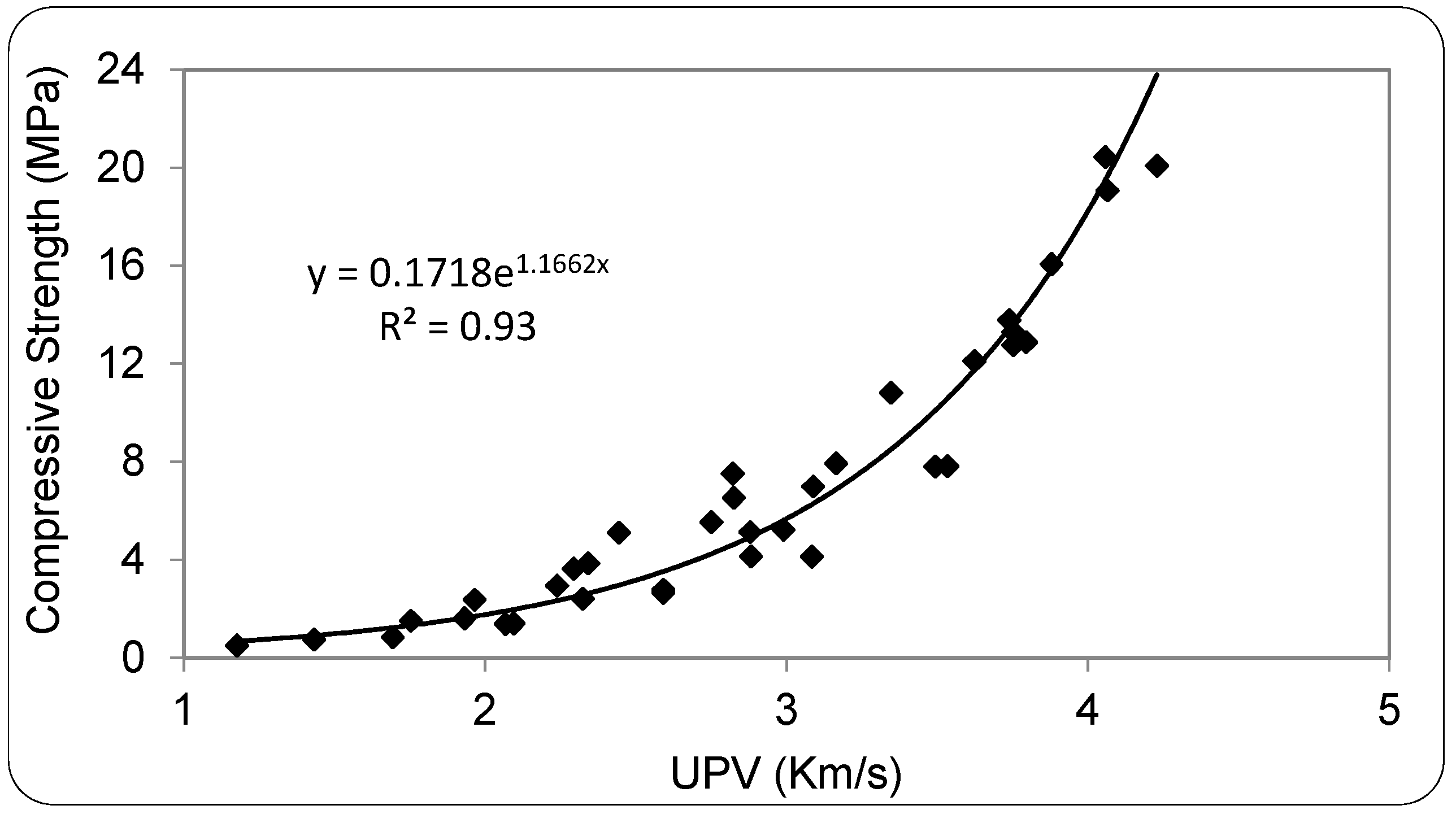
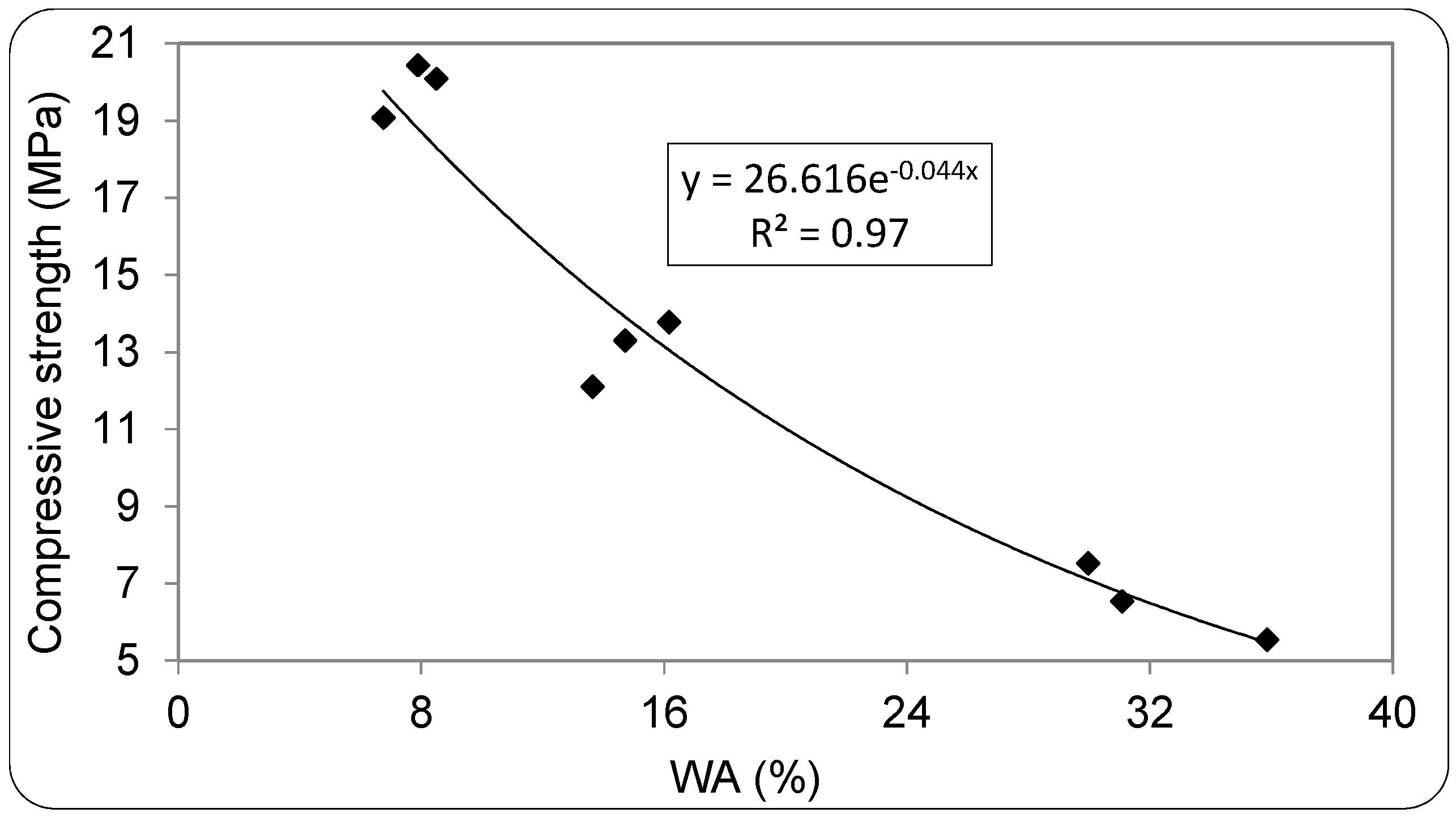
| Constituent | Values (%) | |
|---|---|---|
| Fly Ash | Cement | |
| Loss on ignition | 23 | 1.5 |
| Insoluble residue | - | 0.5 |
| Brightness | - | 43 |
| SiO2 | 45.06 | 22.8 |
| Al2O3 | 16.94 | 3.8 |
| Fe2O3 | 9.04 | 1.4 |
| CaO | 1.96 | 66.5 |
| MgO | 1.02 | 0.8 |
| SO3 | - | 3.3 |
| K2O | 1.4 | 0.7 |
| Na2O | 0.34 | 0.1 |
| Cl | - | <0.1 |
| Flexural tensile strength (28 Days) | - | 9.9 (MPa) |
| Compressive strength (28 Days) | - | 75.5 (MPa) |
| Properties | SPS Aggregate | Natural Aggregate |
|---|---|---|
| Bulk density (kg/m3) | 457 | 1673 |
| Specific gravity (SSD) | 0.80 | 2.67 |
| Water absorption 24h (%) | 13.0 | 1.1 |
| W/B | Mix No. | SPS (%) | FA (%) | Mix Constituents | Slump (mm) | ||||
|---|---|---|---|---|---|---|---|---|---|
| Binders (kg/m3) | Aggregates (kg/m3) | Water (kg/m3) | |||||||
| Cement | FA | NA | SPS | ||||||
| 0.8 | 1 | 0 | 0 | 320 | 0 | 1920 | 0 | 256 | 8 |
| 2 | 60 | 0 | 320 | 0 | 768 | 345 | 256 | 44 | |
| 3 | 100 | 0 | 320 | 0 | 0 | 575 | 256 | 25 | |
| 4 | 0 | 20 | 256 | 64 | 1920 | 0 | 256 | 5 | |
| 5 | 60 | 20 | 256 | 64 | 768 | 345 | 256 | 35 | |
| 6 | 100 | 20 | 256 | 64 | 0 | 575 | 256 | 20 | |
| 7 | 0 | 40 | 192 | 128 | 1920 | 0 | 256 | 3 | |
| 8 | 60 | 40 | 192 | 128 | 768 | 345 | 256 | 25 | |
| 9 | 100 | 40 | 192 | 128 | 0 | 575 | 256 | 15 | |
| Class | I | II | III |
|---|---|---|---|
| Type of lightweight concrete | Structural | Structural and Insulating | Insulating |
| Cylinder compressive strength (MPa) | >15.0 | >3.5 | >0.5 |
| Oven-dry density (kg/m3) | <2000 | not specified | not specified |
| Coefficient of thermal conductivity (W/mK) | - | <0.75 | <0.30 |
| Mix No. | WA (%) | |||||||
|---|---|---|---|---|---|---|---|---|
| 1 Day | 7 Days | 28 Days | 360 Days | |||||
| 30 min | Total | 30 min | Total | 30 min | Total | 30 min | Total | |
| 1 | 8.45 | 9.59 | 4.22 | 9.72 | 2.82 | 9.46 | 2.63 | 8.49 |
| 2 | 17.29 | 18.53 | 11.56 | 20.09 | 7.54 | 18.55 | 7.06 | 16.16 |
| 3 | 36.09 | 37.87 | 34.97 | 41.48 | 28.49 | 40.12 | 19.35 | 35.86 |
| 4 | 9.41 | 10.15 | 7.46 | 10.39 | 5.05 | 10.08 | 3.54 | 7.89 |
| 5 | 18.75 | 20.09 | 15.01 | 20.16 | 10.93 | 19.83 | 7.91 | 14.71 |
| 6 | 39.98 | 42.65 | 39.52 | 43.70 | 30.98 | 42.89 | 18.37 | 31.08 |
| 7 | 10.03 | 10.67 | 9.00 | 10.72 | 6.44 | 10.52 | 2.60 | 6.75 |
| 8 | 19.61 | 20.94 | 18.53 | 21.26 | 13.11 | 20.67 | 5.99 | 13.64 |
| 9 | 41.84 | 45.02 | 42.70 | 46.27 | 32.49 | 44.78 | 16.99 | 29.97 |
© 2017 by the author. Licensee MDPI, Basel, Switzerland. This article is an open access article distributed under the terms and conditions of the Creative Commons Attribution (CC BY) license (http://creativecommons.org/licenses/by/4.0/).
Share and Cite
Herki, B.M.A. Combined Effects of Densified Polystyrene and Unprocessed Fly Ash on Concrete Engineering Properties. Buildings 2017, 7, 77. https://doi.org/10.3390/buildings7030077
Herki BMA. Combined Effects of Densified Polystyrene and Unprocessed Fly Ash on Concrete Engineering Properties. Buildings. 2017; 7(3):77. https://doi.org/10.3390/buildings7030077
Chicago/Turabian StyleHerki, Bengin M. A. 2017. "Combined Effects of Densified Polystyrene and Unprocessed Fly Ash on Concrete Engineering Properties" Buildings 7, no. 3: 77. https://doi.org/10.3390/buildings7030077




